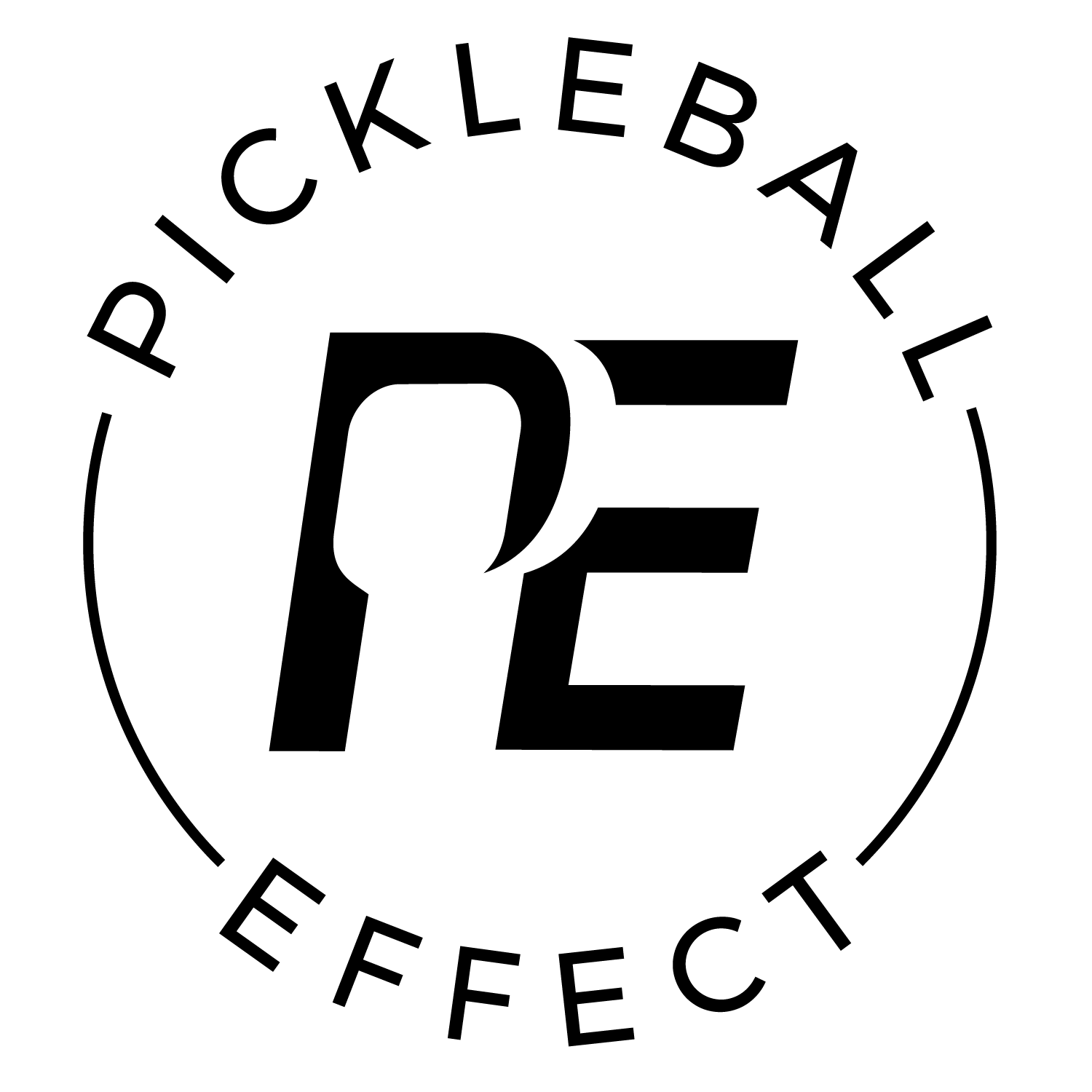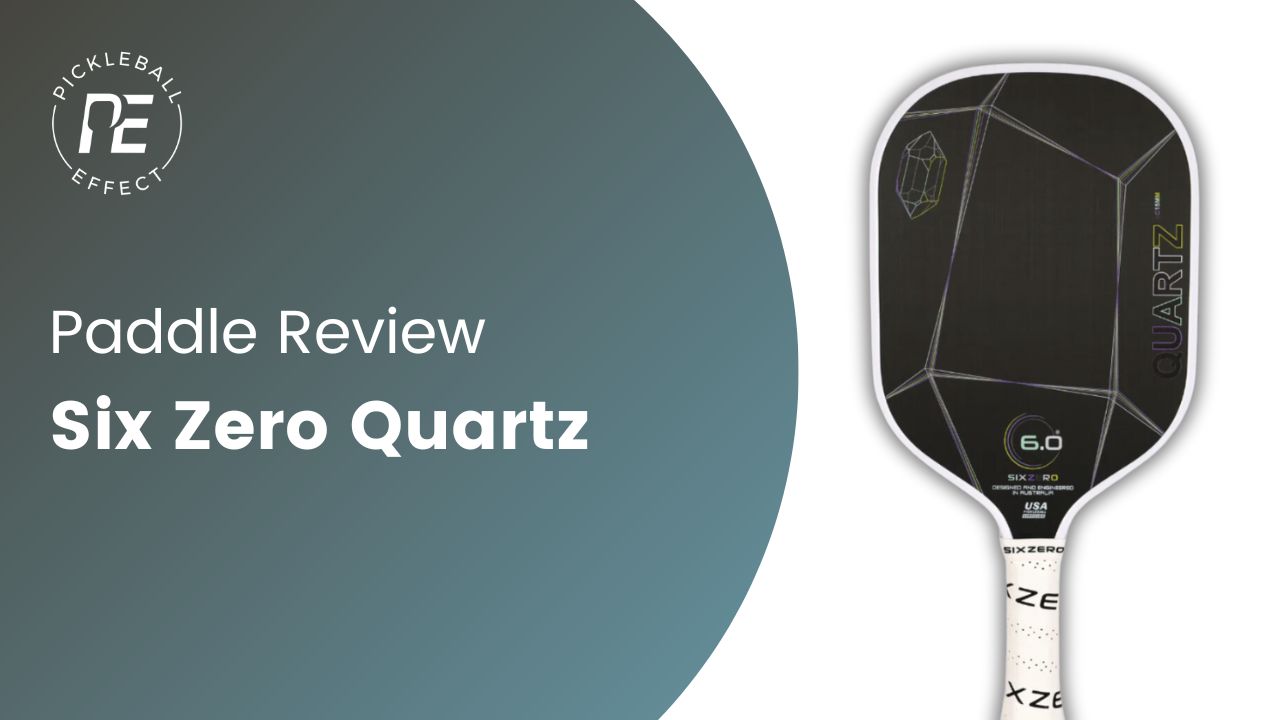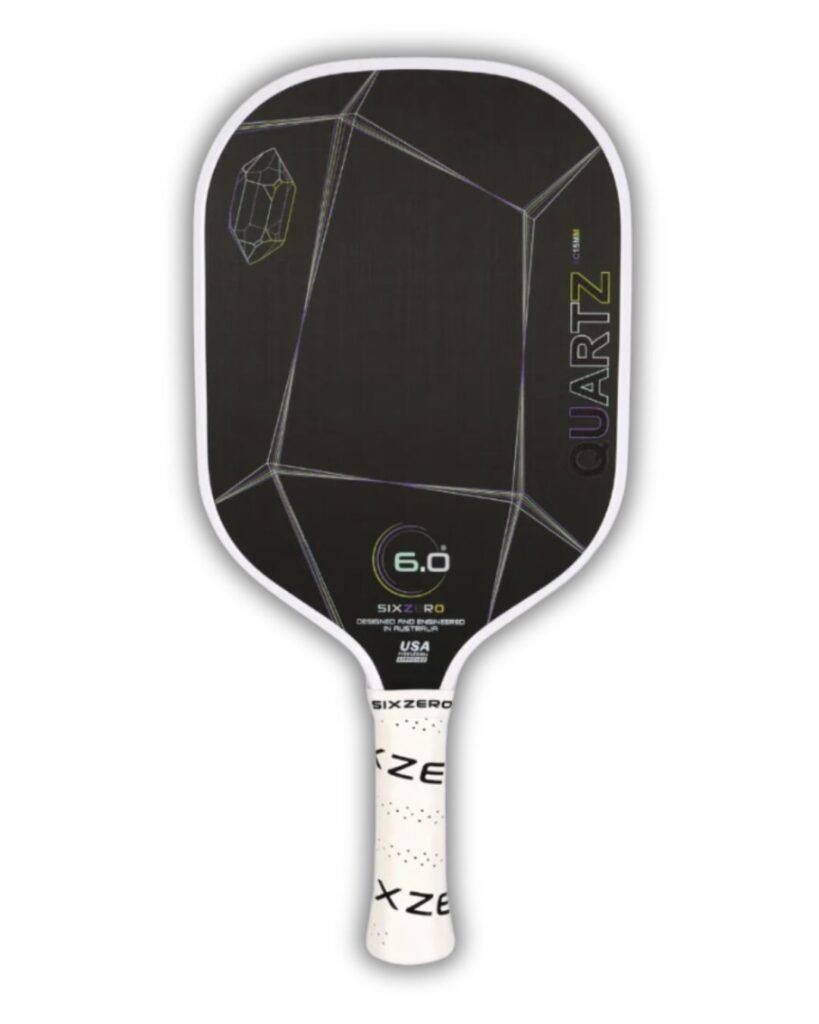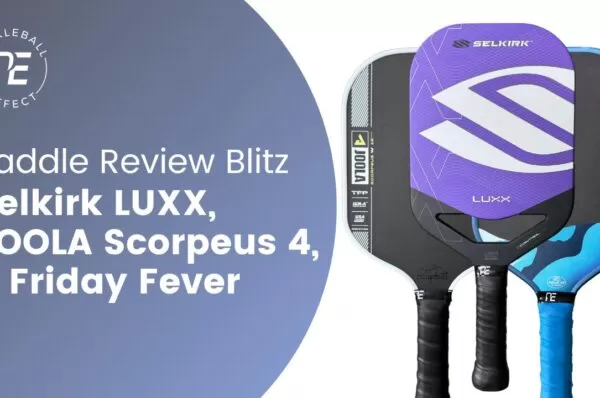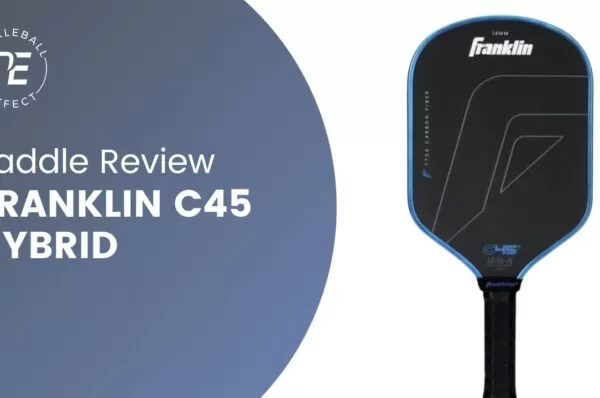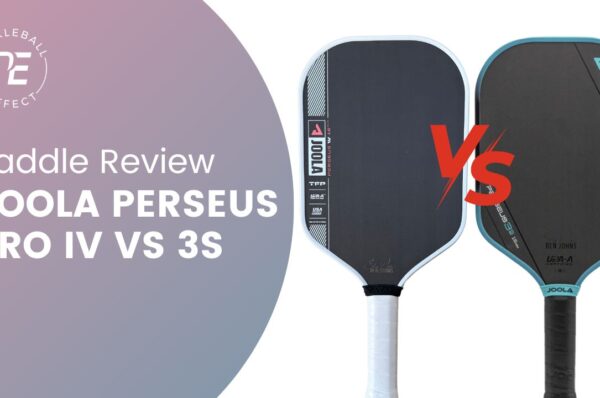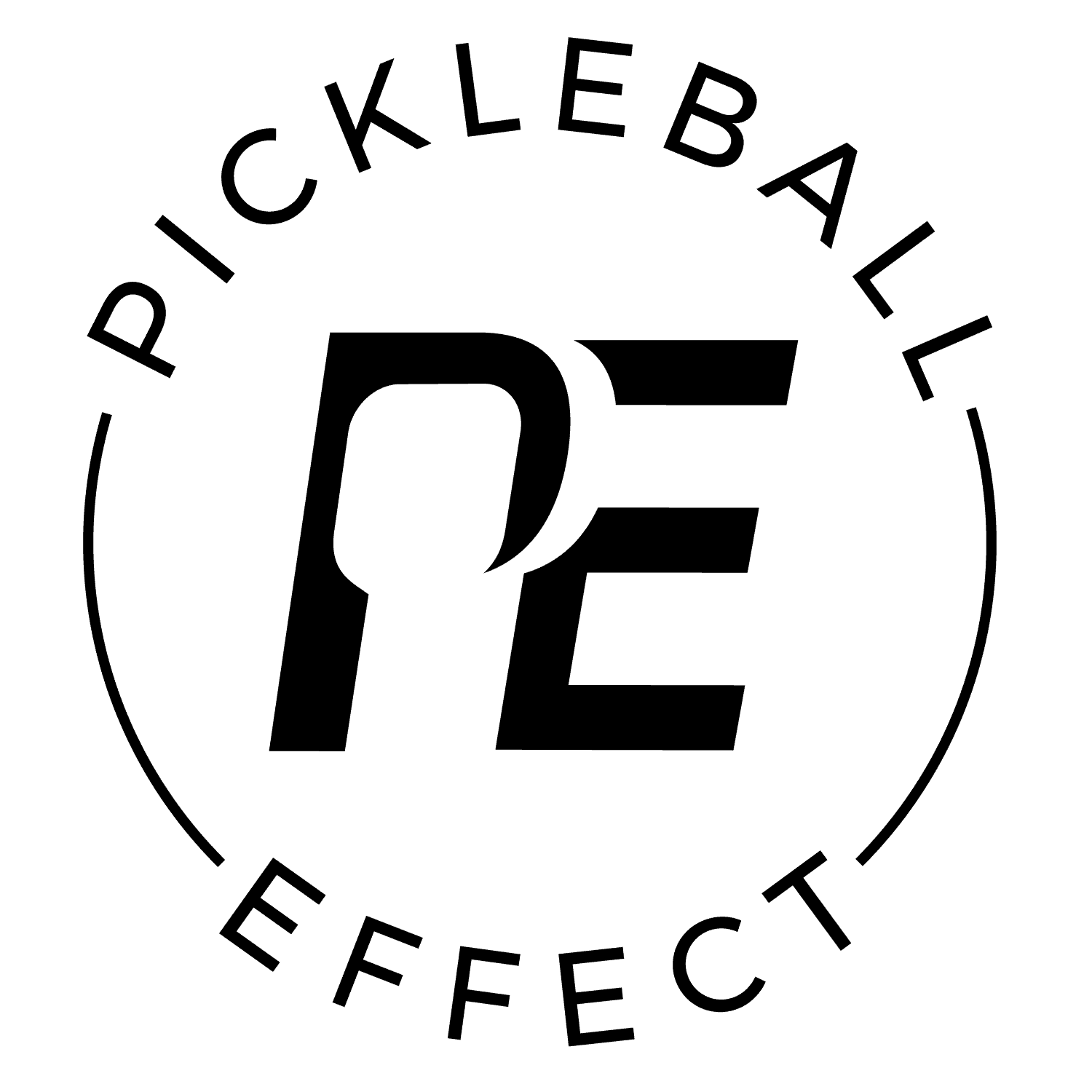Six Zero is introducing a performance entry level paddle with the Quartz. The Vatic Pro Prism paddles have dominated this space for the past year and a half. With the release of the Quartz and recently the Jelly Bean by 11SIX24, I see these three paddles as the main contenders in the performance budget paddle category. In this review I share my thoughts on how the Quartz plays and how it compares to these other performance budget paddles.
Table of Contents
Paddle Stats & Tech
Quartz
- Static Weight: 7.9 oz avg
- Swingweight: 108 (very low)
- Twistweight: 6.4 (moderate)
- Spin RPMs: 1949 (high)
- Length x Width: 16″ x 7.9″ (standard)
- Face: T300 carbon fiber
- Grip Circumference: 4.25″
- Handle Length: 5″
- Core: 15mm Polypropylene Honeycomb
- Special Features: Classic gen 1 style paddle, not thermoformed, no perimeter foam
- Paddle Type: Control
- Price: $89.99 ($81 with code 10EFFECT)
- Warranty: Six month warranty for core crushing, one year warranty for everything else. Details here >>
(Get 10% off with the discount code 10EFFECT directly on their website)
The Quartz paddle has a lower swingweight, even for a standard shaped paddle, making it feel light and very easy to maneuver which has its pros and cons that I’ll speak to in the Performance Summary. Then the twistweight is lower compared to other standard-shaped paddles. Typically, standard-shaped paddles have a higher twistweight of 6.8+ and you can feel that the Quartz has a tighter sweet spot compared to similar standard shaped paddles. I was surprised that they did not utilize perimeter foam injection with this model, but the classic Gen 1 design contributes to its comfortable feel and lower power output which may have been what their going for. Or maybe it was a cost savings move by them. But, in my opinion, I bet the perimeter foam would have helped the twistweight and forgiveness of the paddle without negatively impacting the control and think it’s a miss on their part. Finally, the 15mm design is somewhat unique, you don’t see many paddles with that spec, it’s usually 16mm or 14mm. They were probably trying to give the paddle a little power boost by going with the 15mm over the more common 16mm design because it’s a gen 1 style paddle which is known for playing softer.
Performance Summary
The Quartz plays very control oriented and has a super soft, comfortable feel to it. Its comfortable feel combined with its ability to absorb pace off the ball gives it a higher level of control and generally reduces errors and pop ups. You have to give it a little extra from the midcourt and baseline though to get it over the net, so if you have difficultly generating any of your own power then it may be too control oriented for you. But I imagine this wouldn’t be an issue for most players.
The 15mm design gives it a little pop and somewhat lively feel when dinking, but not much, I’d still describe it as a pure control paddle. My power tests put the paddle at the 5th percentile for power and the 18th percentile for pop in my paddle database. The spin was solid and it spins the ball nearly as well as any of Six Zero’s paddles. My spin test gave it an average of 1945 RPMs which is a great result.
The paddle’s 15mm core and classic gen 1 design without the foam perimeter reduces the size of the sweet spot some. It’s still a forgiving paddle, but it isn’t a huge sweet spot and you can feel some twisting in your hands more than other standard shaped paddles when you connect with the ball around the edges the. When you play it side by side other good $100 paddles like the Vatic Pro Prism Flash and 11SIX24 Jelly Bean, it’s not as forgiving. I don’t think any entry level players would complain about the size of the sweet spot of the Quartz, but it’s worth noting.
Offensively, the paddle is very light and moves easy which is helpful during hand battles but it’s so light that it gets pushed around by the ball a little and their isn’t much plow through. Generating power on serves, drives, and overheads requires more effort and even then, it doesn’t give much to you.
For new players who don’t have much racket experience I think the lighter weight and controllable nature of this paddle is good for them. The soft game and reducing unforced errors are the hardest elements to learn when you’re starting out so this paddle will help in that area. Plus, power isn’t needed as much for new players because they are usually playing other players at their level and it doesn’t take as much power to win points, just good placement. And the Quartz helps you place the ball well with it’s good control and spin ratings. But I would reserve my recommendation of this paddle to beginners only, more advanced players would need to add weight and would be left wanting more.
Finally, you have to talk about all the color options. There are a lot of fun colored paddles out there in the beginner space, but not many with fun colors and good performance like the Quartz. That’s an attractive element of these paddles.
Comparison to Other Performance Budget Paddles
While I think the Quartz does what it’s intended to do just fine and the price is good, when I stack it against its main competitors in this space, the Vatic Pro Prism Paddles and the 11SIX24 Jelly Bean, I don’t think it performs as well.
The Quartz paddle is similar to the Vatic Pro Prism but with a little smaller sweet spot. The Vatic Pro Prism paddles do everything the Quartz can do but is more forgiving and has more options like two thicknesses and and two different handle lengths you can choose from to better suit your preferences.
Then, if you don’t want a pure control paddle and need help generating some power then I’d go with the Jelly Bean over the Quartz and the Vatic Pro Prism.
The only reason you might go with the Quartz over the other two is if you like the fun designs and colors of the Quartz. The Quartz is more fun looking and they offer a lot more colors than the other two paddles.
My Recommendation
Six Zero is obviously targeting entry level players here and it serves that purpose well. It’s less expensive, has good spin, will help improve your soft game, and has an above average sized sweet spot, though not oversized, which is a lot more than what the majority of $80 paddles can say. Particularly, those from other bigger brands like Selkirk or JOOLA. Plus, all the different colors are appealing to that market. But the reviewer in me puts a premium on performance over looks and I think there are better performing paddles in the Vatic Pro Prism series and 11SIX24 Jelly Bean which both only cost $10 more than the Quartz. I would feel confident recommending the Prism paddles and Jelly Bean to entry and higher level players but would reserve my recommendations of the Quartz to entry level players.
(Get 10% off with the discount code 10EFFECT directly on their website.
Braydon competes at the 5.0 level and plays in 5-10 tournaments a year. He plays/drills 3 to 4 times a week and would play more if time allowed it.

Paddle Terms Glossary
We’ve categorized paddles into three categories. Control, All-Court, and Power. Paddle categories are determined by Braydon after he hits or reviews the paddle.
- Control paddles offer a softer feel and better absorbs pace off the ball but doesn’t give you as much power.
- All-Court paddles give you a blend of power and control and does well at everything though it doesn’t excel at anything.
- Power paddles often have a firmer feel and will return more power but are harder to control.
A paddle’s weight represents the inherent mass of the paddle as measured on a scale. However, relying solely on this static weight measurement can be misleading when assessing the true perceived heaviness of the paddle. Even if two paddles both clock in at 8 oz, their actual heft in your hand can markedly differ due to variations in weight distribution within the paddle. This is why the static weight should be considered with the swingweight of the paddle. See the definition of swingweight below.
The weight value listed in the database corresponds to the paddle’s weight that I used to gather the swingweight and twistweight measurement. It’s possible that if your paddle has a different static weight than then the swingweight and twistweight may be slightly different.
There are three primary shapes a paddle can have which consists of the length and width of the paddle. These three shapes are:
- Elongated: The dimensions for an elongated paddle are 16.5″ x 7.5″.
- Standard: A standard shaped paddle has dimensions of 16″ x 8″.
- Hybrid: A hybrid shaped paddle falls somewhere in between the standard and elongated shapes, with approximate dimensions of 16.25″ x 7.5″-7.7″.
Then there are two less common shapes you’ll see. These are:
- Extra-Elongated: This shape is 17″ x 7″
- Widebody: This any paddle shorter than 16″ long.
When considering the advantages and trade-offs of paddle shapes, it’s important to understand the characteristics of each shape.
- Elongated Paddle: An elongated paddle offers increased reach, spin, and power. However, this additional reach comes at the expense of forgiveness, particularly from side-to-side.
- Standard Paddle: In contrast, a standard-shaped paddle provides less reach and a little less power & spin but offers greater overall forgiveness. This means that while you may not have the same extended reach as an elongated paddle, you gain better control and stability.
- Hybrid Paddle: The hybrid shape serves as a middle ground between the elongated and standard shapes. It provides a balance between reach and forgiveness, offering players a versatile option that combines aspects of both shapes.
It’s interesting to note that advanced players often prefer elongated shapes. On the other hand, players at lower skill levels typically opt for the extra forgiveness offered by standard shaped paddles.
Ultimately, the choice of paddle shape depends on an individual’s playing style, preferences, and skill level. Whether your focus is on reach or forgiveness, understanding the unique benefits and trade-offs of each shape can assist you in selecting the paddle that best suits your game.
Swingweight is a measure of the paddle’s resistance to swinging about the end of the handle. The higher the swingweight number the heavier it will feel in your hands. A higher swingweight has more power but is harder to swing, lower swingweight is easier to swing but has less power. Sometimes a faster swing with a lower swingweight can make up for power lost in swingweight. The price paid for that is greater impact shock. Stock swingweights will vary between 100 – 140.
Twistweight is the resistance to rotating around the long axis through the middle of the paddle from butt to tip. The higher the twistweight the more resistance the paddle has to rotating on off center hits. This measurement is closely related to the amount of forgiveness or the size of the sweet spot of the paddle. A higher twistweight indicates a bigger sweet spot. Twistweight numbers range from 5 – 8.
Measuring the revolutions per minute (RPMs) off of a serve you get a number that shows the spin potential of a paddle. Using these RPM measurements I’ve created five buckets that a paddle will fall into indicating its overall spin potential. The five buckets are:
1900 or Higher = Very High
1700 – 1900 = High
1500 – 1700 = Medium
1300 – 1500 = Low
1300 or less = Very Low
You can tell a big difference in the amount of spin a paddle generates when you compare a Very High paddle to a low paddle. But the gains from Medium to High to Very High are marginal. We’ve found that having at least a medium rating is often enough if you’re looking for a good spin paddle. However, if you’re a big hitter then you will benefit more from a high spin paddle to help you keep the ball in play more often.
The power level of a paddle is shown in miles per hour (MPH) after taking ten measurements with a speed gun of hitting a serve as hard as I can. This measurement gives you an idea of how hard you can hit the ball when given the chance to take a full swing. So shots like serves, drives and overheads. The higher the MPH reading the more power you can generate with the paddle.
I also show the percentile ranking of the measurement to give you an idea of how it stacks up against the rest of the paddles in my database.
The pop level of a paddle is shown in miles per hour (MPH) after taking the average of ten speed gun measurements of hitting a punch volley as hard as I can. This measurement gives you an idea of how hard you can hit the ball on shorter swings and gives you an idea of how quickly a ball comes off the face when you apply less force on the ball. So shots volleys, dinks, counters, and resets are all affected by the pop measurement. The higher the pop measurement the stronger your counters will be but it takes more skill to keep the ball from floating or popping up on you when resetting a hard hit ball or when dinking.
I also show the percentile ranking of the measurement to give you an idea of how it stacks up against the rest of the paddles in my database.
The term “forgiveness” pertains to both the size of the sweet spot and the stability of the paddle. A paddle that is more forgiving offers a larger sweet spot, greater stability, and yields more power when hitting off-center shots. On the other hand, a less forgiving paddle has a smaller sweet spot and does not provide as much power when hitting off-center shots.
While there seems to be only benefits of more forgiving paddles, less forgiving paddles are often more maneuverable and is easier to generate more paddle speed.
